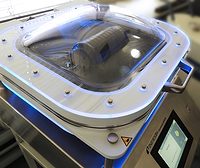A Close Look at Coffee Safety: Shelf Life from Bean to Cup

Ponderosa Roasting Coffee Company is dedicated to producing safe and quality coffees for their customers. This is a process that starts with the green coffee beans that we purchase, the roaster we use, our equipment maintenance and all the way to packaging and shipping.
How We Choose Farms/Regions/Co-Ops
Because we feel that the quality of the coffees we offer starts with the green coffee beans we order, we work primarily with two green bean brokers who have direct relationships with the coffee farms. There are many coffee brokers out there who sell green coffee beans. But we want to sell coffee that has a purpose, coffee that helps people from the farm to the cup. To make this happen, the coffee brokers we work with have a huge network of farms that they work with. This means that the buyer has traveled to the location of the farm. Spent time building a relationship with the farm owners, worked with them to understand their process for growing and processing coffee. They also take the time to work with them on how to improve their coffees and make their farms safer and more sustainable. They take the time to do what is known as cupping in the industry, where the coffee is taste tested for imperfections.
While this often times means that we are paying more money for the green coffee beans, it also means that we are helping support a farm that is often owned and operated by a family. There are many farms out there that operate as an organic or earth friendly farm, yet they don’t have the monetary resources to obtain these certifications.
Once the coffee is shipped to the United States it is commonly stored in a warehouse in burlap sacks. This is the traditional way coffee is shipped from the farms. Each burlap sack weighs approximately at 60 to 70 kg. Some farms have converted to using what is called a GreenPro bag within the burlap sack to increase the beans ability to retain moisture. Because there is a high moisture content in the coffee bean that is fresh from the farm, it is important that when you store your coffee in your warehouse, you do what you can to maintain the moisture of the bean. To accomplish this, we have rubber barrels that we line with the GreenPro bags with lids to store the green coffee in. If the coffee is shipped to us without the GreenPro bag, we will recycle bags to help retain as much moisture in the beans as possible. The other benefit to storing them in these barrels is that you prevent any type of insect from getting into the coffee beans. As the green coffee beans age, they lose moisture content and thus the flavor of the coffee changes as it is roasted. This is why the choice of roasting equipment is so very important.
The Roasting Equipment
The coffee roaster we use is a Renegade Roaster with the addition of the Rebel Touch screen control. This coffee roaster is the most environmentally friendly and efficient coffee roaster available in the industry that also offers a redundancy of safety features that prevent problems from arising in the event that one measure fails. When we first start the machine, it runs through a list of checks prior to the roaster burner even being able to light. If there is no airflow, the burner will not ignite. The burner itself operates at 99.9 percent energy efficiency and only uses what amount of burner is needed to obtain the temperature that is required in the recipe. This makes it not only energy efficient but also cost efficient and ensures the safety of the final product. Because the roaster is operated by electronics, there are sensors that produce alert screens on the touch screen if there are issues. We believe that the less heat you have to use to roast the coffee, the better the tasting the coffee will be. Because our recipes can be controlled so closely, we can actually control the burner within each step of the recipe to a specific degree per minute temp. This means that we are able to state that we want the roaster to increase or maintain a specific temperature different for each step of the roast.
The Renegade Roaster also offers the ability to control the drum speed at each step of the recipe. This is important to our coffee, as we have found that there is a distinct difference when you change the drum speed even in small adjustments or only make adjustments to the drum speed in a recipe.
Two other safety features of the roaster that are extremely important is the alarm that sounds when the roaster has completed its recipe. When the alarm sounds, the stirflex and cooling fan turn on so that the person roasting only has to open the door of the roaster to let the beans out. This is an extremely important feature on the roaster as the person roasting could be bagging coffee or getting the next batch ready and not watching the roaster closely to know when the recipe has ended. Additionally, there is a high limit feature to the roaster that is redundant in the controls, as well as, the electrical components that monitor the temperature of the roaster. If the roaster reaches that temperature that means there is a problem somewhere and the roaster will turn off while continuing the drum rotation to prevent the drum from seizing due to the heat in the metal.
The roaster also offers a cooling time of less than 4 minutes. This is important to the roasting process, when your coffee is done roasting, you drop the roasted coffee into what is called the cooling tray. The faster you can remove the heat from the bean, the better tasting coffee you have. If you have tasted bitter coffee in the past, this could be part of what causes that bitterness.
Equipment Maintenance
The standard process for maintaining the roaster is that after every 150 roasts you plan to clean your roaster. Each time the roaster is cleaned and sanitized, it is inspected to determine whether the number of roasts done between cleaning needs to be increased or decreased. If done routinely, this process is not that time consuming, as the ducting is easily disassembled. We have the optimal distance of 4 feet and all electrical and gas lines are run overhead around the roaster for easy maneuvering for the cleaning without the possibility of tripping or incurring any injuries. The roaster needs to be cold to perform the maintenance of the equipment so it is often best to do this first thing in the morning prior to starting the roaster for the day.
By following the proper maintenance and sanitation schedules, you increase the safety of your roaster as you are removing the chaff builds up on the ducting. The chaff is a skin that comes off the coffee beans much like what comes off a corn kernel when popping popcorn. It is highly flammable and needs to be carefully monitored. This is especially true when roasting coffee dark. To have the proper safety measures in place we have a water source near the roaster, as well as, a fire extinguisher.
If the maintenance schedule is not performed, this could not only cause a fire in the roaster or the roaster ducting and can also cause the roasted coffee to change taste. This is because of the restricted airflow. It is better not only for the equipment but also for the taste and ultimate safety of the coffee to keep to the maintenance schedule.
Post Roasting
We make sure to bag the coffee as soon as it is roasted, as it goes through the degassing process. By bagging the coffee immediately, we prevent the atmospheric conditions to start degrading the coffee, potentially affecting both safety and quality. Coffee releases a gas for the first 72 hours after being roasted. If you drink the coffee within those 72 hours, it will still taste good, but you may notice what is referred to as brightness that wouldn’t be there after the 72 hours. Brightness is an acidity that isn’t in the coffee during its optimal drinking period. This can be sped up if you are taking your coffee to a high altitude, like in a plane or if the coffee is left in the open air and not a sealed container after being roasted. This is why it is so important to pack the coffee in a foil bag with a valve on it.
Roasted coffee doesn’t have an extremely long shelf life. Depending on how dark you purchase, your roasted coffee determines the pace for the coffees degradation. If you prefer dark roasted coffee, you will find that coffee has a shorter shelf life than a medium roasted coffee. This is because as you roast the coffee darker, more of the oils found inside the bean make their way to the surface of the bean. This increases over time on all roasted coffee beans, but because the dark roast brings those oils to the surface during the roasting process, you will notice a shorter shelf life before the coffee starts to take on a bitter taste.
While there are those who order their coffee pre-ground, there are those who like to grind their own coffee beans. The coffee will always taste its best and has a longer shelf life if you grind it just before brewing. While many commonly believe that a grinder that is a whirly bird grinder works fine, it is a known problem in the coffee industry. This is because you can’t get a consistent grind for all beans in the chamber, which can result in a bitter tasting coffee. Herein lies the reason why we recommend the purchase of a burr grinder. The coffee filters through the grinder into a bin to keep the grind even and offers the end drinker a fabulous cup of coffee.
We also recommend to our customers to store their coffee whether purchased whole bean or ground to store their coffee in a glass or ceramic airtight container. This will increase the shelf life of their coffee, as air is what shortens the shelf life of coffee and causes the flavors to become less appealing. While many have heard that their coffee will have a longer shelf life if it is stored in the refrigerator or freezer, this is not necessarily true. When you freeze or refrigerate your coffee, you are adding moisture to the coffee beans or grounds that wasn’t there before. If you brew the coffee straight from either place, you will find that this will affect the taste of your coffee, especially if it is stored in an open bag and subjected to the other items in your refrigerator or freezer that could alter the taste of your coffee. If you choose to store your coffee in either a refrigerator or freezer, it is best to allow what you are using to brew at the moment to return to room temperature prior to brewing.
Ponderosa Roasting Coffee Company is a small micro-roaster based in San Diego, CA. Please visit www.ponderosaroasting.com/ for more information.
Looking for a reprint of this article?
From high-res PDFs to custom plaques, order your copy today!








